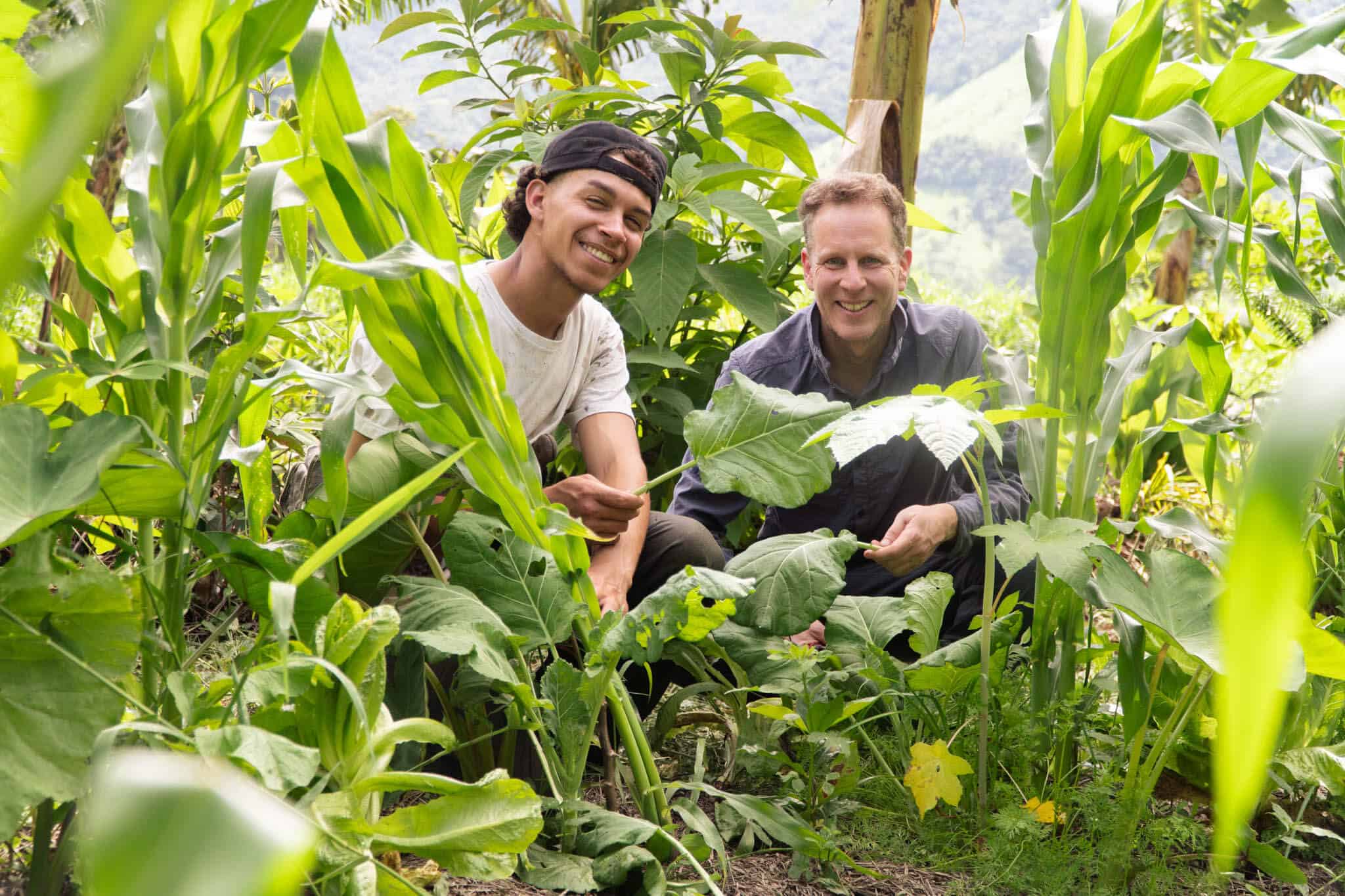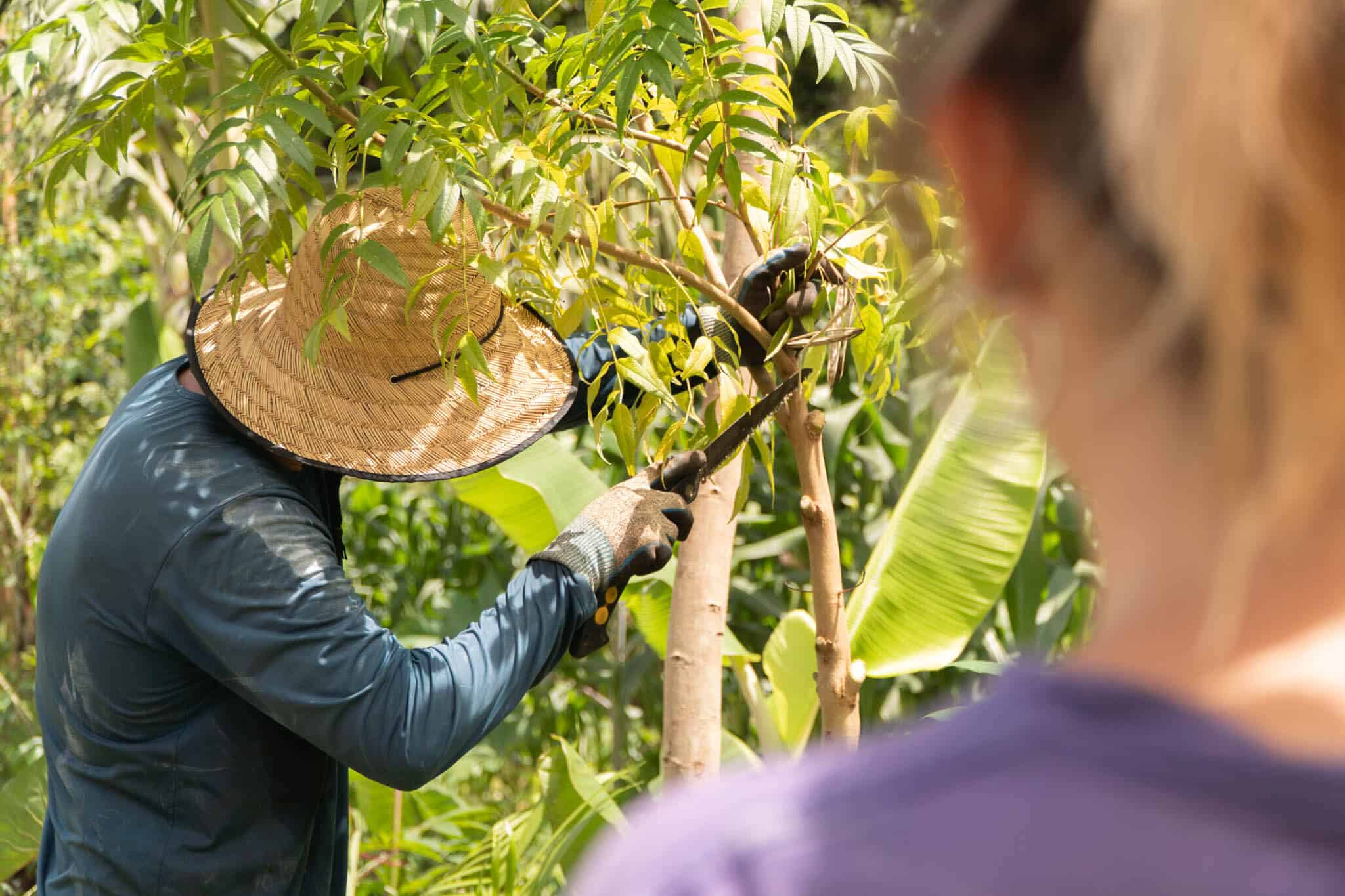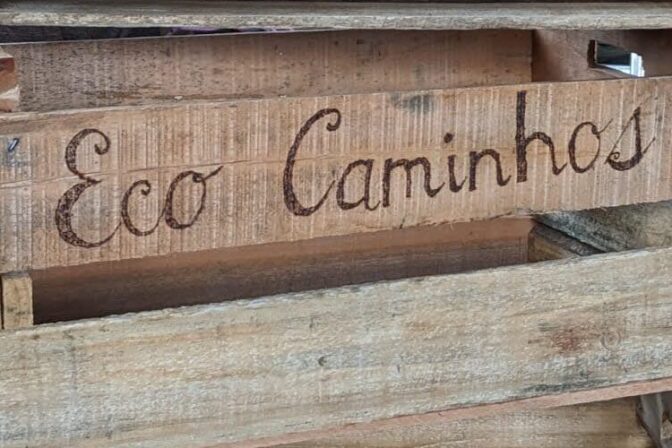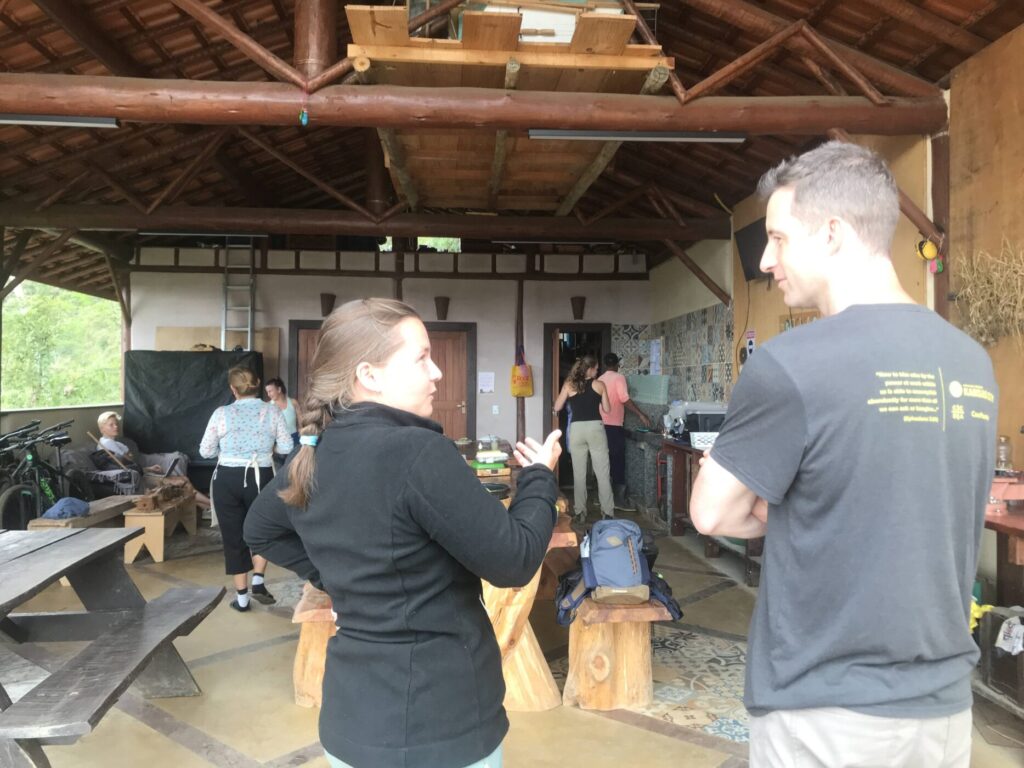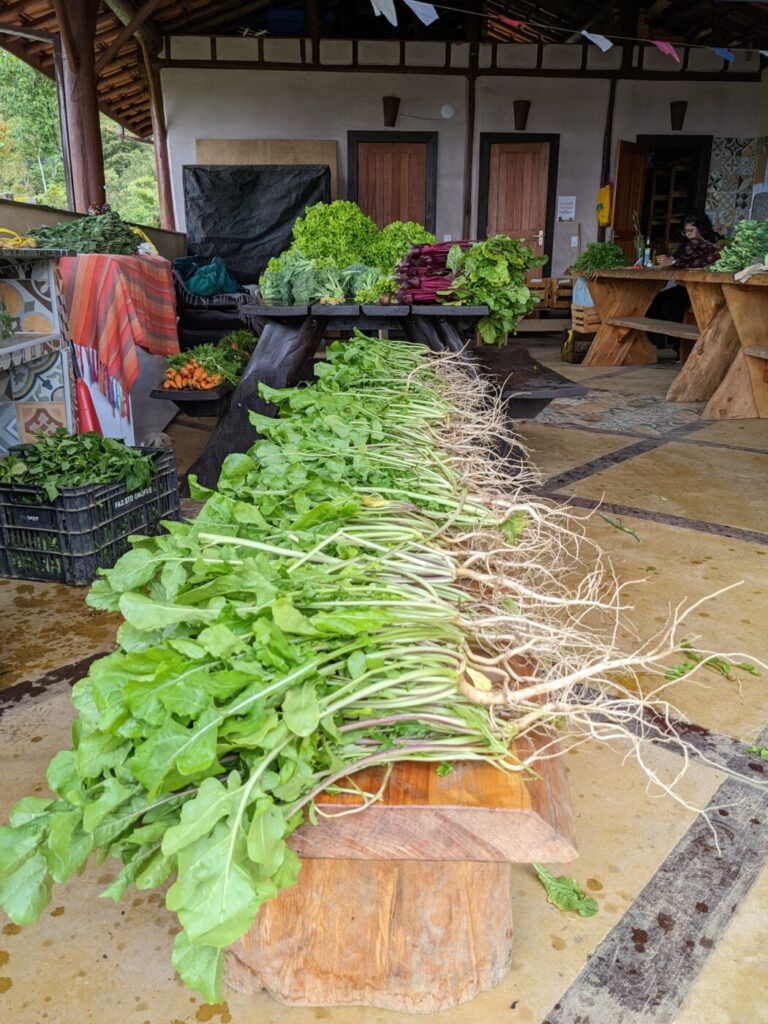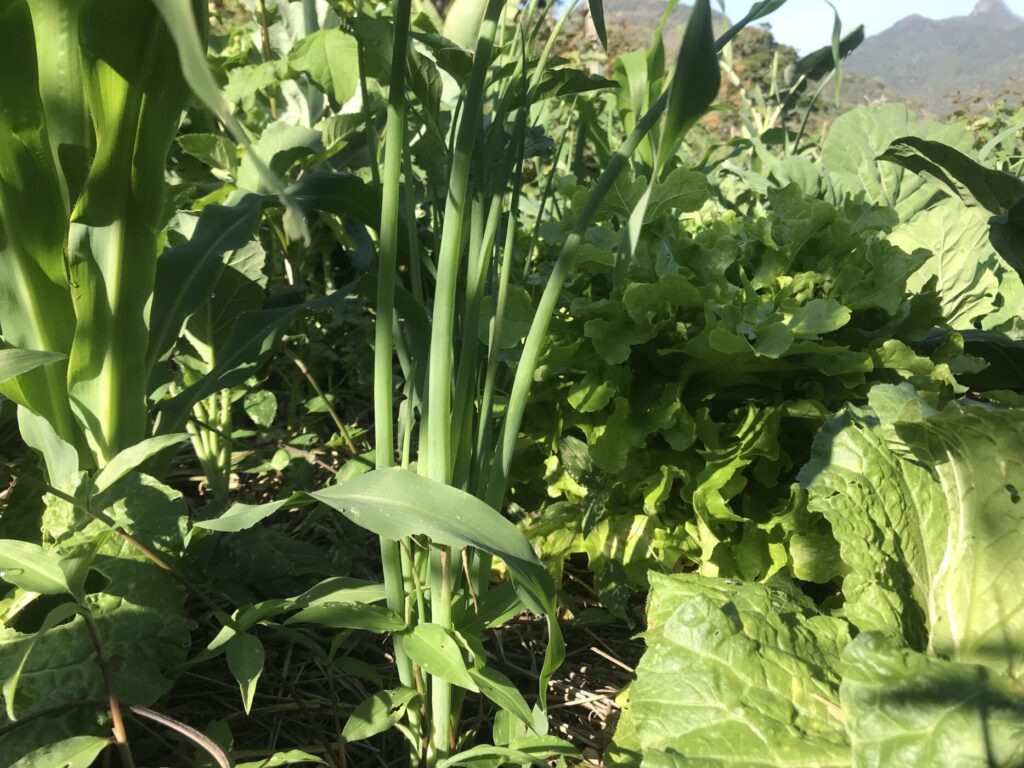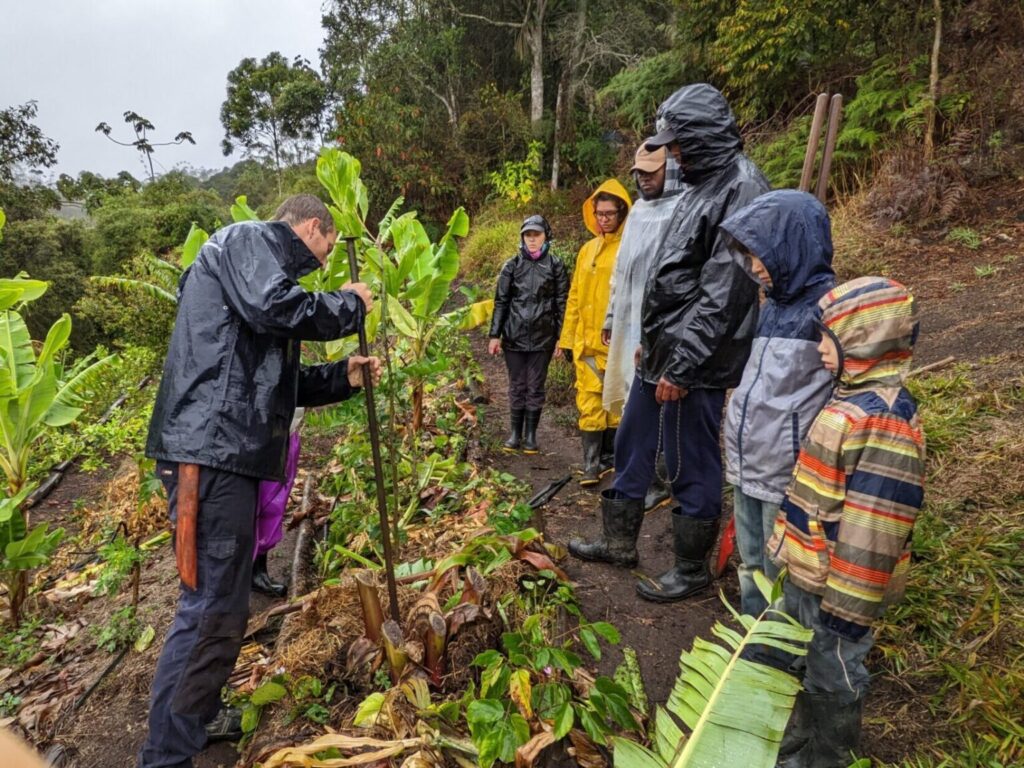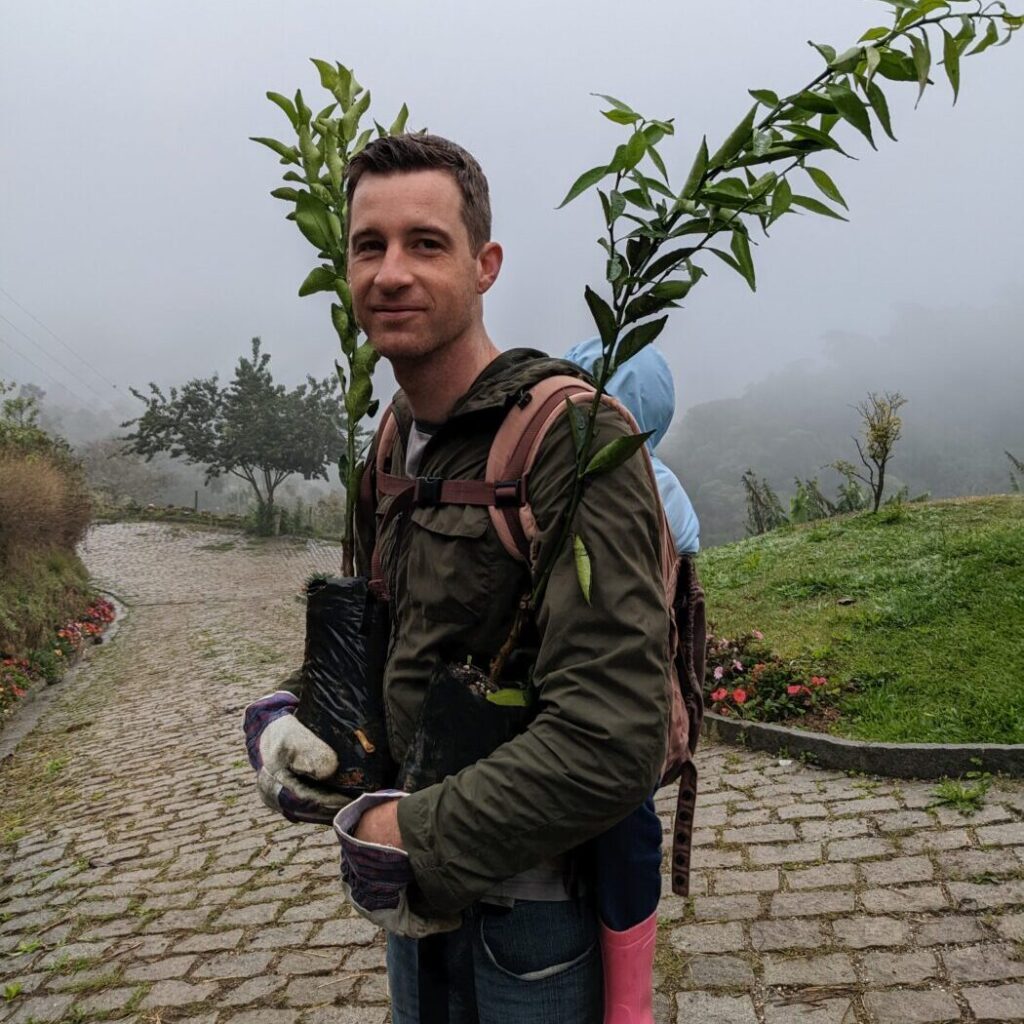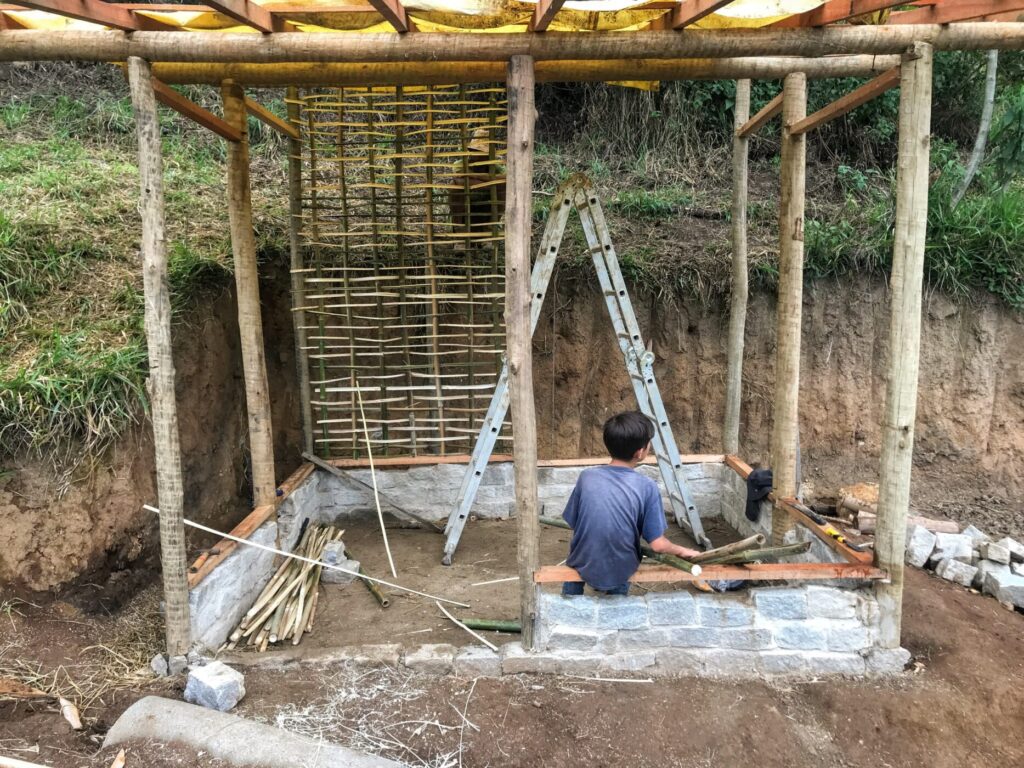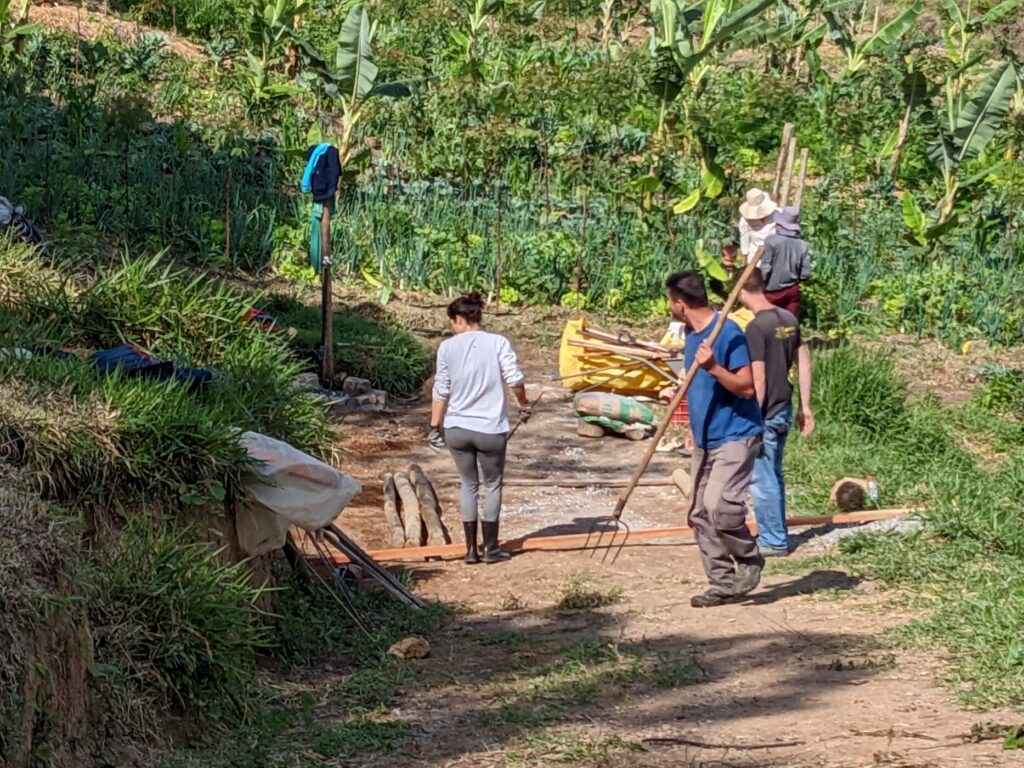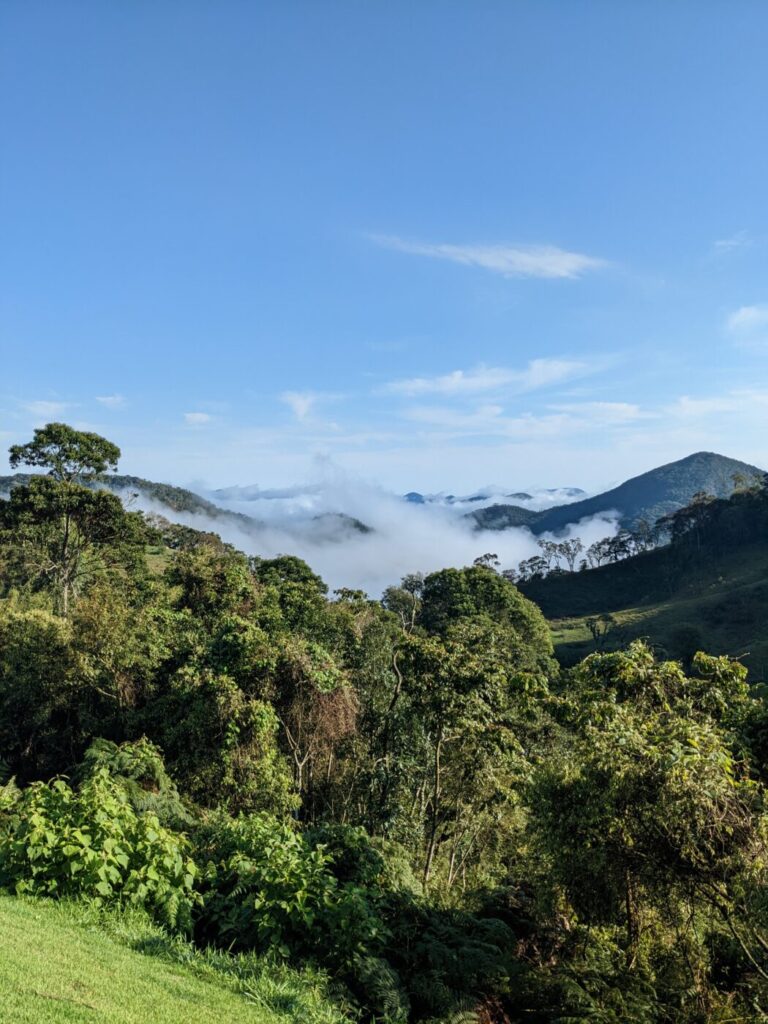[vc_row css=”.vc_custom_1739379399395{margin-right: 30px !important;margin-left: 30px !important;}”][vc_column][swmsc_text_block id=”” class=”” style=””]Having left my work in the field of international development cooperation, mostly working outside and directly with and for people in conflict zones, it was a major change to spend the last four years in the financial sector. Working Inside an office or inside my home, mostly just in the company of my laptop and going through the typical nine to five job, creates the need to try and balance out the back pain from sitting for hours and watching the screen, with yoga, sports and a gym membership. It became clear another big change was needed.
Volunteering felt like a great way to forget about finance for a while, both those of the bank I worked at as well as my own and simply enjoy the opportunity to contribute to something meaningful without the typical obligations of a regular job or the financial gain. Here at Eco Caminhos farm where the permaculture mentality serves as an overarching principle, no gym membership is needed and the right balance is in the daily work itself, filled with moments of physical activity and healthy food. So where exactly is here?[/swmsc_text_block][gap size=”30px” id=”” class=”” style=””][gap size=”30px” id=”” class=”” style=””][/vc_column][/vc_row][vc_row css=”.vc_custom_1740408802641{margin-right: 30px !important;margin-left: 30px !important;}”][vc_column width=”1/2″][swmsc_text_block id=”” class=”” style=””]
The Majestic Mata Atlântica
The majestic Atlantic Forest, or Mata Atlântica, before colonial times still the second largest rainforest on the planet with an impressive 1- 1.5 million km2, has all but been deforested. Only around 15% of the original area remains, with many plant and animal species threatened with extinction. At the same time, astonishingly this area currently contains around that same percentage of the world’s biodiversity, with even more species being discovered every day.
At 1.200m altitude at the Eco Caminhos farm, I am lucky to have an amazing view over part of that 15% while sipping quality coffee and enjoying homemade bread during our morning break. It is here that as a volunteer I am learning the basics on concepts such as agroforestry, permaculture and bioconstruction, how and why these are being applied here at the farm and the benefits they provide, to both people and nature.
The stunning views of the natural landscape with all its diversity, are complemented by a mix just as impressive, that of the international volunteers, local apprentices and staff. From Canada to Japan, Colombia to Korea, criss-crossing the European continent and various regions of Brazil, it has all come together on this farm with similar goals in mind: to connect, to contribute and to learn.[/swmsc_text_block][gap size=”30px” id=”” class=”” style=””][/vc_column][vc_column width=”1/2″][swmsc_image_gallery border_radius=”0″ border_width=”0″ border_color=”#e6e6e6″ image_margin=”20px” image_size=”full” columns=”1″ grid_type=”masonry” image_text=”none” hover_icon_color=”#ffffff” hover_icon_bg_color=”#f8b54e” title_text_size=”20px” title_text_color=”#555555″ caption_text_size=”16px” caption_text_color=”#777777″ caption_border=”off” id=”” class=”” style=”” image_ids=”27142,27144″][/vc_column][/vc_row][vc_row css=”.vc_custom_1739379399395{margin-right: 30px !important;margin-left: 30px !important;}”][vc_column][swmsc_image_gallery border_radius=”5px” border_width=”0″ border_color=”#e6e6e6″ image_margin=”20px” image_size=”full” columns=”3″ grid_type=”none” image_text=”none” hover_icon_color=”#ffffff” hover_icon_bg_color=”#f8b54e” title_text_size=”20px” title_text_color=”#555555″ caption_text_size=”16px” caption_text_color=”#777777″ caption_border=”off” id=”” class=”” style=””][gap size=”30px” id=”” class=”” style=””][swmsc_text_block id=”” class=”” style=””]
Agroforestry
As part of the agroforestry presentation and hands-on experience in the respective systems, we learn for example about the different stratums or layers that are there now and will be there in the future, as the fields are constantly evolving. Every time you prune, you bring the system to a higher level. The higher advanced the forest, the richer the biomass. So what takes place here, is a constant accumulation of quality we are told. First though, comes the basic task of weeding, before wielding the machete. Getting our hands dirty clearing the soil around the coffee plants, the cash crop integrated into the agroforestry systems, we understand that the goal here is not the coffee itself but to bring back the forest. The coffee is a means to an end, to make it all possible. A Mico monkey seems to be interested in the explanations as well and is happily observing us from above, before it decides to jump over to one of the large banana trees and make off with one of its fruits.[/swmsc_text_block][swmsc_image_gallery border_radius=”0px” border_width=”0″ border_color=”#e6e6e6″ image_margin=”20px” image_size=”full” columns=”2″ grid_type=”masonry” image_text=”none” hover_icon_color=”#ffffff” hover_icon_bg_color=”#f8b54e” title_text_size=”20px” title_text_color=”#555555″ caption_text_size=”16px” caption_text_color=”#777777″ caption_border=”off” id=”” class=”” style=”” image_ids=”27159,27160,27161,27162″][gap size=”30px” id=”” class=”” style=””][/vc_column][/vc_row][vc_row css=”.vc_custom_1739379399395{margin-right: 30px !important;margin-left: 30px !important;}”][vc_column][swmsc_image_gallery border_radius=”5px” border_width=”0″ border_color=”#e6e6e6″ image_margin=”20px” image_size=”full” columns=”3″ grid_type=”none” image_text=”none” hover_icon_color=”#ffffff” hover_icon_bg_color=”#f8b54e” title_text_size=”20px” title_text_color=”#555555″ caption_text_size=”16px” caption_text_color=”#777777″ caption_border=”off” id=”” class=”” style=””][gap size=”30px” id=”” class=”” style=””][swmsc_text_block id=”” class=”” style=””]
Bioconstruction
After a theoretical basic introduction to bioconstruction, it’s time to not just get our hands dirty, but also our feet. To the tune of Colombian salsa, we dance around with bare feet in a mix of clay, sand, water and dried grass. Adding more of one or the other ingredient as we go along, the mix slowly gets the consistency and quality needed to be used as building material, called cob. We are a bit further down the hill from the main farm and it is here that we are building the future. Ecolibrium, as the project is called, is not just the future of the farm, but the future of the region, according to the vision of Bart, the founder of Eco Caminhos and president of the Ecolibrium Association.
With around 1200 m3, Ecolibrium is one of the biggest bioconstruction projects in Latin America and is to be a knowledge centre meant for capacity building, educational partnerships and events and with the goal in mind of developing a social impact in the region and beyond. While trying to stick the cob to the wall and smear it out in an evenly manner (something much harder than you would think), we listen to Bart explaining that the vision of Ecolibrium is to create a consciousness in the region that harmonizes agriculture, life and community with nature. Focused on passing this knowledge on to the next generation by teaching the principles of permaculture, agroforestry and bioconstruction to a local and global audience. [/swmsc_text_block][swmsc_image_gallery border_radius=”0px” border_width=”0″ border_color=”#e6e6e6″ image_margin=”20px” image_size=”full” columns=”2″ grid_type=”masonry” image_text=”none” hover_icon_color=”#ffffff” hover_icon_bg_color=”#f8b54e” title_text_size=”20px” title_text_color=”#555555″ caption_text_size=”16px” caption_text_color=”#777777″ caption_border=”off” id=”” class=”” style=”” image_ids=”27166,27167,27168,27169″][gap size=”30px” id=”” class=”” style=””][/vc_column][/vc_row][vc_row css=”.vc_custom_1740408854358{margin-right: 30px !important;margin-left: 30px !important;}”][vc_column width=”1/2″ css=”.vc_custom_1740579636539{margin-right: 100px !important;padding-right: 50px !important;}”][gap size=”30px” id=”” class=”” style=””][gap size=”30px” id=”” class=”” style=””][swmsc_image link=”#” lightbox=”true” target=”_self” lightbox_type=”image” align=”left” alt=”” title=”” border_radius=”0px” id=”” class=”” style=”” src=”27171″][/vc_column][vc_column width=”1/2″][gap size=”30px” id=”” class=”” style=””][swmsc_text_block id=”” class=”” style=””]
Dreaming Big
It sounds big. And it is. But dreaming big and sticking to it is also what Eco Caminhos is about as I quickly learn and looking around to what we are doing and the global audience that is already present, it seems and feels like the project is definitely on its way there. For some though, it all may seem too much, too crazy, for others it is seriously doing something about the state of the world. For me it is also sometimes mind-blowing hearing all the different components that together form this grand vision but whatever you think and most of all, it is nothing short of admirable and inspirational.
Lunch time is often a great moment to come back together after everyone is spread out over the farm and it is where we share experiences, ideas and discuss on the state of the world or simply enjoy fresh and delicious food straight from the farm. A family with kids who have also been joining for a few weeks explains explicitly choosing Eco Caminhos over Ipanema beach with the clear purpose of exposing their next generation early on to this kind of a setting, philosophy and way of life. Looking out over the Mata Atlântica at the same time as I hear these words, it all just seems to make so much sense and the vision we hear about on different occasions and that is woven through the daily work, seems to be just around the corner. [/swmsc_text_block][/vc_column][/vc_row][vc_row css=”.vc_custom_1740408854358{margin-right: 30px !important;margin-left: 30px !important;}”][vc_column width=”1/2″ css=”.vc_custom_1740579636539{margin-right: 100px !important;padding-right: 50px !important;}”][gap size=”30px” id=”” class=”” style=””][swmsc_text_block id=”” class=”” style=””]
Hard Work Slicing Banana Trees
However, clearing out the mud or cob that I have managed to get all over my face on one of the bioconstruction days and feeling the muscle pain in my arms, it is also important to note that this here is not the romantic version of life on a sustainable farm where you chill in a hammock and simply watch nature take care of itself. Or smoke a joint while hugging a tree as the joke sometimes goes. Nothing of the sort. It is definitely hard work. It is very physical and of course slicing huge banana tree trunks for hours into tiny pieces to be used as biomass for the coffee plants can be monotonous besides tiring. Especially taking into account the heat and humidity and all the walking up and down the agroforestry lines on a steep hill which doesn’t make it any easier. Pesky mosquitos, huge spiders and venomous snakes are all there to make it even more of a challenge.
But is it worth it? Oh absolutely. How often do you get the chance to wake up in the middle of such a lush and green environment, contributing to its preservation, restoration and expansion while sharing this experience with a diverse and inspirational group of people from all walks of life and backgrounds? And of course, as a way to balance out the hard work, there is also plenty of time for fun and games. Whether in the form of ping pong tournaments or board and card games, nature hikes or mountain bike rides, social nights and BBQ’s, it all contributes to balance out the physical hardship with social connections and encounters on other levels. Oh, and did I mention the waterfall at a stone’s throw from the volunteer housing? And another dozen or so within walking distance, one even more beautiful than the other. Refreshing as well as rewarding after a long and hot day.[/swmsc_text_block][gap size=”30px” id=”” class=”” style=””][/vc_column][vc_column width=”1/2″][gap size=”30px” id=”” class=”” style=””][swmsc_image_gallery border_radius=”0″ border_width=”0″ border_color=”#e6e6e6″ image_margin=”20px” image_size=”full” columns=”1″ grid_type=”masonry” image_text=”none” hover_icon_color=”#ffffff” hover_icon_bg_color=”#f8b54e” title_text_size=”20px” title_text_color=”#555555″ caption_text_size=”16px” caption_text_color=”#777777″ caption_border=”off” id=”” class=”” style=”” image_ids=”27173,27174,27176″][gap size=”30px” id=”” class=”” style=””][gap size=”30px” id=”” class=”” style=””][/vc_column][/vc_row][vc_row css=”.vc_custom_1740408920006{margin-right: 30px !important;margin-left: 30px !important;}”][vc_column width=”1/2″][gap size=”30px” id=”” class=”” style=””][gap size=”30px” id=”” class=”” style=””][swmsc_image_gallery border_radius=”0″ border_width=”0″ border_color=”#e6e6e6″ image_margin=”20px” image_size=”full” columns=”1″ grid_type=”masonry” image_text=”none” hover_icon_color=”#ffffff” hover_icon_bg_color=”#f8b54e” title_text_size=”20px” title_text_color=”#555555″ caption_text_size=”16px” caption_text_color=”#777777″ caption_border=”off” id=”” class=”” style=”” image_ids=”27178,27183″][/vc_column][vc_column width=”1/2″][swmsc_text_block id=”” class=”” style=””]
University of life
When that is not enough, part of the permaculture mentality also teaches us that patience is key and seeing the tasks that we do and also ourselves as part of the process while knowing that everything that is done on the farm has a reason (there is no randomness here), gives a feeling of purpose. At the same time, repetition and discipline require practicality. For this reason, the farm wants to stand out in simplicity, observing examples from nature itself, this being something that we seem to have lost over time and need to relearn. And I feel this is definitely a good place to do just that.
As the only species that has the choice to either screw things up or improve them, it is great to see that while losing a game of ping pong to one of the young apprentices, the project has given these youth the opportunity and they have clearly taken the chance, making that choice for the better. Also in this respect, the Eco Caminhos space could be seen as a little university of life, revolving around a mindset change where community life, need for collaboration and at the same time the isolation function as a constant mirror for self-reflection and improvement. In all we hear, it becomes clear how the future, represented by the Ecolibrium space, will greatly expand the social component of the farm and reach a multitude of children and youth as it does now. With energy and motivation, I happily wake up at 6am the next morning to start another day of hard work making cob and splashing the magical mix as a final finish on the walls. [/swmsc_text_block][/vc_column][/vc_row][vc_row css=”.vc_custom_1731520578623{margin-right: 20px !important;margin-left: 20px !important;}”][vc_column][gap size=”30px” id=”” class=”” style=””][swmsc_text_block id=”” class=”” style=””]
Constant accumulation of quality
We are currently working towards finishing the first phase, or around one third, of the Ecolibrium space. In need of lots of financing and with all that is going on and is still to come as part of the project, it is sometimes hard to imagine how it will all be realized. But hearing about the middle way, or ‘thinking as a company but acting with the heart’, illustrates the approach that is taken. Not for the money, but because of the eagerness and need for results. Generating sufficient income to be self-sustaining requires sometimes difficult decisions but practical steps, while never losing sight though of the social impact the project wants to achieve.
Exchanging banking for building and finance for farming was definitely another major change in life and it has been a lot to take in these weeks so far at Eco Caminhos. However, one thing is clear, it is indeed a constant accumulation of quality, in every way imaginable. Quality of food, fresh air and stimulating conversations, purifying the stomach as well as the mind. Quality of astonishing visual surroundings, human connections and sounds of nature. Day in day out, all the while seeing the agroforestry systems develop and the bioconstruction site grow. Spending time at Eco Caminhos feels like accumulating quality of life.
[/swmsc_text_block][vc_single_image image=”27187″ img_size=”large” css=””][/vc_column][/vc_row]
